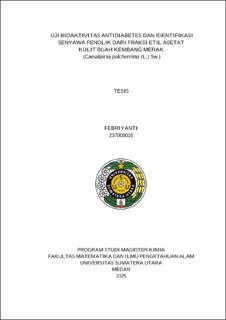Uji Bioaktivitas Antidiabetes dan Identifikasi Senyawa Fenolik dari Fraksi Etil Asetat Kulit Buah Kembang Merak (Caesalpinia pulcherrima (L.) Sw.)
Antidiabetic Bioactivity Test and Identification of Phenolic Compound from Ethyl Acetate Fraction of Peacock Flower Pods (Caesalpinia pulcherrima (L.) Sw.)

Date
2025Author
Febriyanti, Febriyanti
Advisor(s)
Lenny, Sovia
Tarigan, Juliati Br
Metadata
Show full item recordAbstract
Peacock flower plant (Caesalpinia pulcherrima (L.) Sw.) is traditionally used in
medicine and is thought to be influenced by the presence of secondary metabolites.
This study aims to test the antidiabetic bioactivity and isolate pure compounds from
ethyl acetate fraction from pods of peacock flower plant. Pods of peacock flower
plant as much as 3 kg was macerated using methanol solvent to produce 469 g
(15.65%) methanol extract, followed by extraction with ethyl acetate to produce 261.
75 g (8.72%) ethyl acetate extract, and then ethyl acetate extract that had been
dissolved with methanol was then partition extracted using n-hexane to produce
65.24 g (2.17%) ethyl acetate fraction. The results of phytochemical screening
showed that the ethyl acetate fraction contained alkaloid, phenolic, flavonoid, and
saponin compounds. Determination of total phenolic content was determined by the
Folin-Ciocalteu method with a linear regression equation of y = 0.106x + 0.0764
with R2 = 0.9278 at 765 nm measurement and obtained a total phenolic content of
326.038 mgGAE/g extract. Antidiabetic bioactivity tested in test animals was divided
into 6 groups, namely the normal group, the negative control group (CMC 1%), the
positive control group (Glibenclamide), and the comparison group with a dosse of
ethyl acetate fraction of 100 mg/KgBB, 200 mg/KgBB, and 400 mg/KgBB. This study
used the oral glucose tolerance test method and data analysis was carried out using
One-Way ANOVA and Post Hoc test. The result showed that the ethyl acetate
fraction of peacock flower pods with dose of 400 mg/KgBB was able to significantly
reduced blood sugar levels compared to negative control (p < 0.05) and the results
were not different from the positive control glibenclamide (p > 0.05), so it was
necessary to isolate active compounds from ethyl acetate fraction of peacock flower
pods. After isolated the compound and elucidated the structure used UV-Vis, FT-IR,
1H-NMR, 13C-NMR, DEPT, and LC-MS/MS data, it was concluded that isolated
compound was a non-flavonoid compound of the phenolic acid group derived from
cinnamic acid, namely ferulic acid.
Collections
- Master Theses [381]
